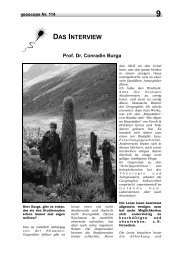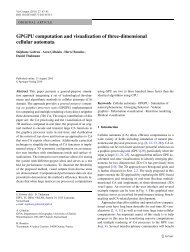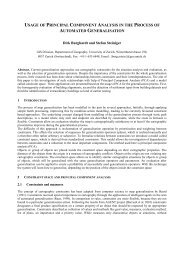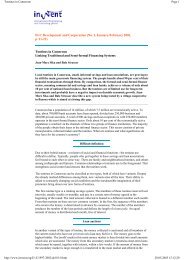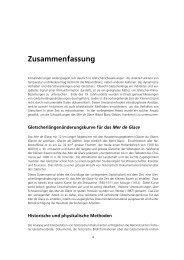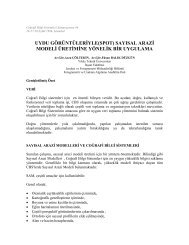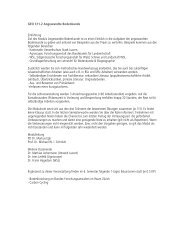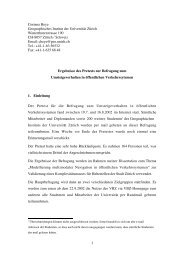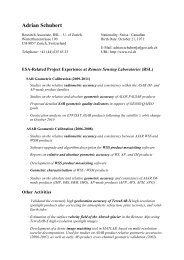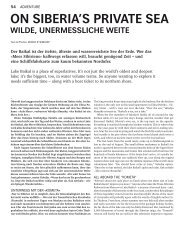KYRGYZSTAN TODAY Policy briefs on - Department of Geography
KYRGYZSTAN TODAY Policy briefs on - Department of Geography
KYRGYZSTAN TODAY Policy briefs on - Department of Geography
You also want an ePaper? Increase the reach of your titles
YUMPU automatically turns print PDFs into web optimized ePapers that Google loves.
the vocati<strong>on</strong>al-educati<strong>on</strong> system should focus primarily <strong>on</strong> the requirements <strong>of</strong> the<br />
domestic labor market.<br />
Labor migrati<strong>on</strong> from Kyrgyzstan and trends in its regulati<strong>on</strong><br />
In the past decade, Kyrgyzstan has actively supplied a labor force to Russia,<br />
Kazakhstan, other CIS countries and some foreign countries. An analysis <strong>of</strong> the current<br />
situati<strong>on</strong> predicts an c<strong>on</strong>tinuati<strong>on</strong> in the trend <strong>of</strong> the outflow <strong>of</strong> “new” emigrants, al<strong>on</strong>g<br />
with significant numbers <strong>of</strong> “old” emigrants. It also suggests that the destinati<strong>on</strong>s<br />
<strong>of</strong> migrants will remain the same, albeit with some diversificati<strong>on</strong>. For example, the<br />
destinati<strong>on</strong>s chosen by potential migrants recently have included Turkey and Korea. 1<br />
The main flow <strong>of</strong> migrant workers remains bey<strong>on</strong>d organized, regulated migrati<strong>on</strong>.<br />
According to various estimates, 80 to 90 percent <strong>of</strong> migrant workers have been leaving<br />
the country through un<strong>of</strong>ficial channels.<br />
Currently, demographic factors have meant that 70-100,000 people annually enter<br />
the labor market <strong>of</strong> Kyrgyzstan, although the absorpti<strong>on</strong> capacity <strong>of</strong> the domestic labor<br />
market is limited. In the current situati<strong>on</strong>, in which the ec<strong>on</strong>omy is developing slowly,<br />
the living standards <strong>of</strong> the populati<strong>on</strong> remain low while the level <strong>of</strong> poverty remains<br />
high. This explains why the state encourages citizens to find work abroad, earn more<br />
m<strong>on</strong>ey, and return remittances through <strong>of</strong>ficial channels.<br />
Al<strong>on</strong>g with such efforts to legally regulate foreign labor migrati<strong>on</strong>, the government<br />
<strong>of</strong> Kyrgyzstan has taken some steps to protect the rights <strong>of</strong> migrants in the countries <strong>of</strong><br />
their work, based <strong>on</strong> internati<strong>on</strong>al c<strong>on</strong>venti<strong>on</strong>s and various bilateral and multilateral<br />
agreements. Those efforts to c<strong>on</strong>trol labor face serious difficulties.<br />
The following argument has become nearly axiomatic: in c<strong>on</strong>necti<strong>on</strong> with the<br />
inevitability <strong>of</strong> emigrati<strong>on</strong> from Kyrgyzstan for work because <strong>of</strong> the nati<strong>on</strong>al ec<strong>on</strong>omic<br />
c<strong>on</strong>diti<strong>on</strong>s, efforts should be made to maximize the benefits <strong>of</strong> migrati<strong>on</strong>– for both the<br />
state and for migrants. The expected benefits include the possibility <strong>of</strong> reducing tensi<strong>on</strong><br />
in the domestic labor market (due to the outflow <strong>of</strong> a part <strong>of</strong> the working populati<strong>on</strong>),<br />
and significant cash remittances sent by emigrants back into the country. To maximize<br />
the benefits <strong>of</strong> migrati<strong>on</strong>, some suggest making the labor resources <strong>of</strong> Kyrgyzstan more<br />
competitive in foreign labor markets, in particular Russia and Kazakhstan.<br />
It is well-known that migrants from Kyrgyzstan (and from the whole <strong>of</strong> Central<br />
Asia) are employed in Russia and Kazakhstan, mainly in low-paid, undervalued jobs.<br />
These jobs, using internati<strong>on</strong>al terminology, fit the so-called “Three Ds” category: dirty,<br />
difficult, dangerous. In other words, the jobs that citizens <strong>of</strong> recipient countries do not<br />
want to do. Managing the export <strong>of</strong> the labor force means that migrant workers should<br />
have the knowledge, skills and qualificati<strong>on</strong>s demanded by foreign labor markets. This<br />
training may improve their competitiveness, allowing them to apply for work that calls<br />
<strong>on</strong> specific skills that are, c<strong>on</strong>sequently, better paid. Higher wages mean greater incomes<br />
<strong>of</strong> migrants and larger transfers <strong>of</strong> m<strong>on</strong>ey to home. It also implies that skilled workers<br />
are better protected from exploitati<strong>on</strong> and violati<strong>on</strong>s <strong>of</strong> their rights.<br />
Kyrgyzstan is not al<strong>on</strong>e in choosing the strategy <strong>of</strong> focused, managed export <strong>of</strong><br />
skilled manpower. Many poor countries with an abundant labor force implement such<br />
policies, improving the marketing <strong>of</strong> their workforce. One <strong>of</strong> the most vivid examples<br />
1<br />
Here and later the author refers to the data <strong>of</strong> the study “Utilizati<strong>on</strong> <strong>of</strong> human resources <strong>of</strong><br />
Kyrgyzstan”, which is yet to be published. The research was c<strong>on</strong>ducted <strong>on</strong> the order <strong>of</strong> ILO in May-July<br />
2008 by a team <strong>of</strong> researchers under the supervisi<strong>on</strong> <strong>of</strong> the author <strong>of</strong> this article.<br />
101






